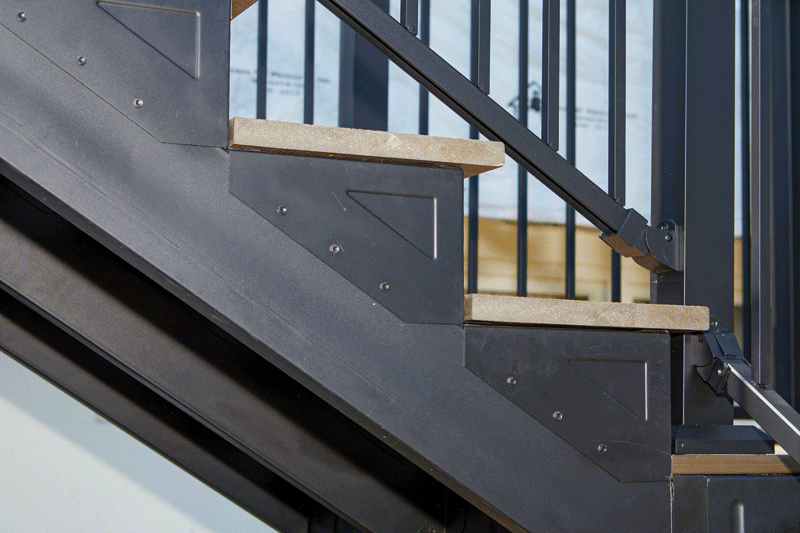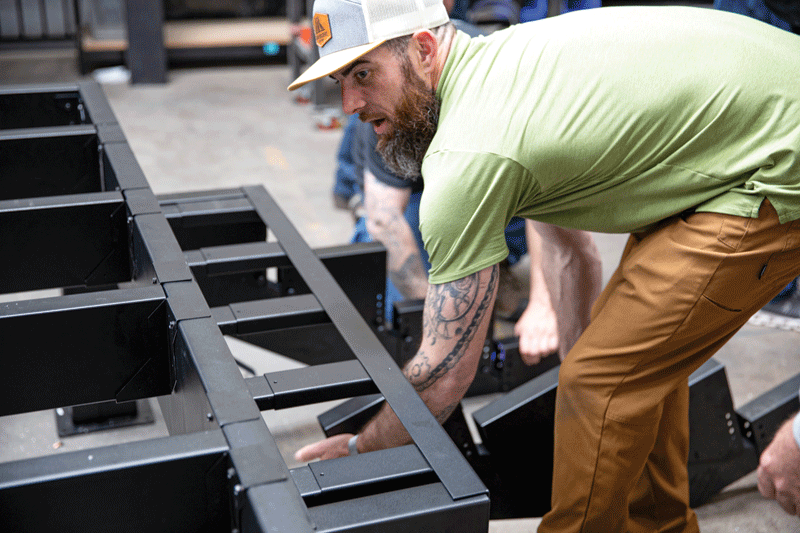Stepping up: Framing deck stairs with steel
by David Flaherty | 8 October 2024 3:40 pm

After a modest downturn in home improvement spending after several frenzied years of activity, homeowners are rolling up their sleeves again. According to the Leading Indicator of Remodeling Activity (LIRA)¹, which is released every quarter by Harvard’s Joint Center for Housing Studies, home remodeling and repair spending is expected to continue trending up through the first half of 2025.
This renewed enthusiasm for home improvement extends beyond the walls of the home to outdoor living spaces. The 2024 U.S. Houzz & Home Study² underlines this trend, reporting that of the homeowners with remodeling projects, 58 percent make exterior improvements and 53 percent prioritize upgrades to their outdoor spaces. Go one step further and look at the most popular types of exterior upgrades, approximately one in every four homeowners are upgrading their deck, porch, or balcony.
Design trends for these types of outdoor structures have grown more pronounced over the years. More than ever, homeowners are carefully evaluating how these spaces look, feel, and function. After all, we recognize these spaces present opportunities to create outdoor living “rooms” that can perform like direct extensions of the home. It is easy to conjure up mental images of a beautifully remodeled deck, complete with stylish railings, wood-emulating surface boards, and upgraded amenities like a luxurious outdoor kitchen and a pergola. But here is the reality of the situation. It is the not-so-glamourous design choices, like the type of deck-building material used, that matter most when it comes to building an outdoor structure with lasting performance and style.
This careful consideration must extend to the building materials used during deck stair construction. After all, the stairs are responsible for ensuring family and friends can safely access and navigate the deck and the surrounding outdoor living area. This is why many contractors are making the switch from wood to steel for deck stair construction. The results speak for themselves. Contractors who frame stairs with steel can deliver a safer, stronger, and structurally sound project that exceeds their client’s expectations.
 [1]
[1]Steel steps up and delivers proven performance in outdoor spaces
Steel’s inherent strength offers contractors whose clients have decided to upgrade their deck stairs a significant advantage. With an ultimate yield strength around 10 times greater than wood, steel is all muscle and brawn. Plus, the building material flexes with force, which is one of the reasons for its success on large construction projects. Its ductile nature helps it withstand high winds, earthquakes, and other stressors.
However, strength is only half the equation when it comes to steel. After all, no homeowner wants to spend their hard-earned money on a deck upgrade only to have the stairs start to degrade after a few years. But that is what can happen to deck stairs framed with a traditional building material like wood.
To its benefit, steel is resistant to the damaging effects of severe weather. Incredibly durable, deck stairs framed with steel make it possible for contractors to sidestep maintenance callbacks from tangible threats that wreak havoc on wood stairs. This is because steel will not deteriorate after
long-term exposure to moisture, split under high-force winds, or warp due to extreme heat or rapid freeze-thaw cycles. In application, deck stairs framed with steel will lay flat and stay that way underneath a homeowner’s feet in nearly any type of climate.
Select outdoor building product manufacturers take additional steps to bolster steel’s weather ability, offering deck stair components manufactured with mild carbon steel (also referred to as low carbon). This is then formed into light-gauge steel (LGS) components found in many commercial buildings. The steel is hot-dip galvanized to G60 standards of 25.5 g (0.90 oz) of zinc coating per sf of steel sheet or higher for enhanced durability and protection from the effects of weathering.
Steel stair framing ensures a fire-safe deck structure
Contractors who are looking for another reason to use steel stairs on a deck upgrade will appreciate the building material is non-combustible. This makes it a smart choice for projects located in densely populated urban areas where fire spread is a concern or for deck remodeling projects located in regions prone to wildfires.
For instance, many contractors working in Chicago are looking for code-compliant, lasting alternatives to wood that meet the city’s landmark Building Code Modernization Ordinance (which requires Class A building materials and methods to be used on roofs during building renovations). After all, history has repeatedly shown us that wood can cause issues in a dense urban environment, where a fire can spread to nearby structures quickly. But steel is a non-combustible building material. This makes steel stairs a code-compliant option for contractors who are working on the rooftop deck projects that are common in the city as owners and tenants look to maximize usable living space.
Outside the urban limits of cities like Chicago, contractors working on deck upgrades located in wildland-urban interface (WUI) areas also have stringent building requirements to meet. WUI zones are defined as geographical areas where homes or businesses meet with combustible wildland vegetation such as timber, brush, or grasses. Under these circumstances, there’s a higher fire risk to people and property. According to the U.S. Fire Administration (USFA),³ more than 60,000 communities in the United States are at risk for wildfires in a WUI zone, and the WUI land area continues to grow by approximately 809,371 ha (2 million acres) per year. While the standards within a WUI building code will vary according to the scope that a community is willing to adopt and enforce, it is recommended only Class A building materials be used. A marker indicating superior fire performance, a Class A designation is the best fire rating a building material or product can receive, and steel deck stairs check off this box. Materials like steel that fall into the Class A category are very unlikely to contribute fuel to a fire, reducing the vulnerability of a structure and the people inside or near it. Ultimately, framing deck stairs with a non-combustible option like steel is the best way to ensure a client’s investment in a wildfire-prone region is money well spent.
 [2]
[2]Comprehensive steel stair systems offer a straightforward installation
Despite the advantages of steel becoming more common knowledge, it is understandable some contractors may still feel hesitant to make the switch from a time-honored building materials like wood to steel for deck upgrades. Not to mention, stair framing is notorious for being one of the most challenging and time-consuming parts of deck building.
However, select outdoor building product manufacturers offer ready-to-assemble steel stair framing systems, which simplify the installation process for contractors. These comprehensive systems do not require additional tools or special industry knowledge to use, which is a mental roadblock for some who are considering converting from wood to steel. Modern engineered stair systems feature fixed and adjustable stair brackets to accommodate various rise and run options. The stringer and stair trays already include blocking every 254 mm (10 in.) on center for easy railing post attachment and stair tread attachment. Additionally, self-drilling screws ensure secure and robust connections. This level of innovation ensures today’s supersized decks remain structurally sound.
Additionally, steel deck stair systems can be used with any type of deck surface board, including composite, polyvinyl chloride (PVC), aluminum, tile, wood, or tropical hardwoods. This design flexibility makes it possible for contractors to bring continuity to the different elements of an outdoor space, without compromising the structural soundness of the deck structure.
Strong, durable, and fire-smart, framing deck stairs with a tested and proven material like steel provides performance benefits that allow contractors to deliver long-lasting outdoor structures. With complete, ready-to-assemble steel deck stair systems available on the marketplace, there has never been a better time to put steel to work in a deck upgrade.
Notes
¹Joint Center for Housing Studies of Harvard University, “Leading Indicator of Remodeling Activity (LIRA),” jchs.harvard.edu/research-areas/remodeling/lira
²2024 U.S. Houzz & Home Study, “Projects & Spend,” st.hzcdn.com/static/econ/2024-US-Houzz&Home-Study.pdf
³U.S. Fire Administration, “What is the WUI?” usfa.fema.gov/wui/what-is-the-wui.html
Jeff Schulz is senior vice president of sales and marketing at Fortress Building Products. A building products industry veteran, Schulz has spent the last 13-plus years at Fortress, delivering proven performance and smarter solutions with the company’s steel deck framing (including the Evolution steel deck framing system and the compatible Evolution steel stair system), pergolas, railing, and fencing.
- [Image]: https://www.metalconstructionnews.com/wp-content/uploads/2024/10/FBP_steel-stair-framing_240416.gif
- [Image]: https://www.metalconstructionnews.com/wp-content/uploads/2024/10/FBP_steel-stair-framing_20240619_114450.gif
Source URL: https://www.metalconstructionnews.com/articles/framing-deck-stairs-with-steel/